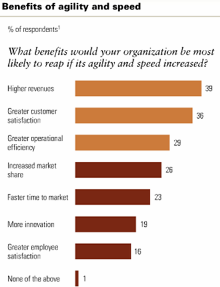
As organizations grow in size and operates from multiple locations, one of the biggest challenges is to maintain flexibility and responsiveness in decision making and execution.Historically organizations that have been able to retain swiftness in decision making despite large scale operations always emerge as winner in the long run.
The findings, from a new McKinsey Quarterly survey, suggest that managers across all main regions and industry sectors acknowledge the increasing significance of agility and speed.
The findings, from a new McKinsey Quarterly survey, suggest that managers across all main regions and industry sectors acknowledge the increasing significance of agility and speed.
In the survey an organization's "agility" was defined as its ability to change tactics or direction quickly—that is, to anticipate, adapt to, and react decisively to events in the business environment. "Speed" was defined as a measure of how rapidly an organization executes an operational or strategic objective.
Some of the major findings are:
Almost nine in ten respondents say agility is either "extremely" or "very" important to business performance, and 86 percent say the same about speed.
The two organizational elements that most contribute to agility and speed, the two top choices (identified by 41 percent and 39 percent of the sample, respectively) were a clear link between company strategy and the performance goals of individual employees and decision-making authority pushed as far down the organization as possible.
Turning to behavioral and attitudinal issues, more than half of the respondents (57 percent) think sensitivity and responsiveness to customer needs constitute the key to increasing agility and speed.
The survey also sought to explore the main organizational, behavioral, and attitudinal barriers to greater agility and speed. Half of the respondents complain about overly centralized, slow, or complex decision-making and approval processes. And around one in four highlight poor coordination and control of multiple initiatives; inconsistent communication of objectives and targets; boundaries, real or imagined, that impede the flow of information and ideas; and unclear accountability.
As for "softer" barriers, one in three respondents cites a lack of employee purpose, commitment, and motivation.
No comments:
Post a Comment